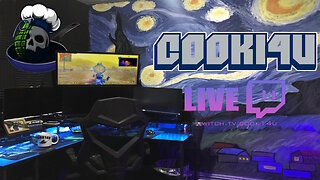Premium Only Content

Mycopharmaceuticals and Nutraceuticals
Cited paper
https://www.ncbi.nlm.nih.gov/pmc/articles/PMC8304235/
References for the cited paper part 1
10.2174/1389557515666150227112445. [PubMed] [CrossRef] [Google Scholar]
12. Kalač P. Chapter 1-Introduction. In: Kalač P., editor. Edible Mushrooms. Academic Press; Cambridge, MA, USA: 2016. pp. 1–6. [Google Scholar]
13. Sabaratnam V., Kah-Hui W., Naidu M., David P.R. Neuronal Health–Can Culinary and Medicinal Mushrooms Help? J. Tradit. Complem. Med. 2013;3:62–68. doi: 10.4103/2225-4110.106549. [PMC free article] [PubMed] [CrossRef] [Google Scholar]
14. Thatoi H., Singdevsachan S.K., Patra J.K. Chapter 5-Prebiotics and Their Production From Unconventional Raw Materials (Mushrooms) In: Grumezescu A.M., Holban A.M., editors. Therapeutic, Probiotic, and Unconventional Food. Academic Press; Cambridge, MA, USA: 2018. pp. 79–99. [Google Scholar]
15. Miles P.G., Chang S.-T. Mushrooms: Cultivation, Utritional Value, Medicinal Effect, and Environmental Impact. CRC Press; Boca Raton, FL, USA: 2004. [Google Scholar]
16. Larmkie H.L., Torgbor J.P.-N., Yaa B.A.M., Christopher S., Matilda D. Sensory Attributes of Three Edible Tropical Mushrooms and Their Use in Formulating Food Products for Children 2–5 Years Old. Int. J. Nutr. Food. Sci. 2018;7:100–109. doi: 10.11648/j.ijnfs.20180703.14. [CrossRef] [Google Scholar]
17. Gupta S., Summuna B., Gupta M., Annepu S.K. Edible Mushrooms: Cultivation, Bioactive Molecules, and Health Benefits. In: Mérillon J.-M., Ramawat K.G., editors. Bioactive Molecules in Food. Springer International Publishing; Cham, Switzerland: 2018. pp. 1–33. [Google Scholar]
18. Al-Obaidi J.R. Proteomics of edible mushrooms: A mini-review. Electrophoresis. 2016;37:1257–1263. doi: 10.1002/elps.201600031. [PubMed] [CrossRef] [Google Scholar]
19. Lee S., Ryoo R., Choi J.H., Kim J.-H., Kim S.-H., Kim K.H. Trichothecene and tremulane sesquiterpenes from a hallucinogenic mushroom Gymnopilus junonius and their cytotoxicity. Arch. Pharm. Res. 2020;43:214–223. doi: 10.1007/s12272-020-01213-6. [PubMed] [CrossRef] [Google Scholar]
20. Prados-Rosales R., Toriola S., Nakouzi A., Chatterjee S., Stark R., Gerfen G., Tumpowsky P., Dadachova E., Casadevall A. Structural Characterization of Melanin Pigments from Commercial Preparations of the Edible Mushroom Auricularia auricula. J. Agric. Food Chem. 2015;63:7326–7332. doi: 10.1021/acs.jafc.5b02713. [PMC free article] [PubMed] [CrossRef] [Google Scholar]
21. De Souza R.A., Kamat N.M., Nadkarni V.S. Purification and characterisation of a sulphur rich melanin from edible mushroom Termitomyces albuminosus Heim. Mycology. 2018;9:296–306. doi: 10.1080/21501203.2018.1494060. [PMC free article] [PubMed] [CrossRef] [Google Scholar]
22. Lindequist U., Niedermeyer T.H., Jülich W.-D. The pharmacological potential of mushrooms. Evid. Based Complement. Altern. Med. 2005;2:285–299. doi: 10.1093/ecam/neh107. [PMC free article] [PubMed] [CrossRef] [Google Scholar]
23. Wu Y., Choi M.-H., Li J., Yang H., Shin H.-J. Mushroom cosmetics: The present and future. Cosmetics. 2016;3:22. doi: 10.3390/cosmetics3030022. [CrossRef] [Google Scholar]
24. Nakalembe I., Kabasa J.D., Olila D. Comparative nutrient composition of selected wild edible mushrooms from two agro-ecological zones, Uganda. SpringerPlus. 2015;4:433. doi: 10.1186/s40064-015-1188-z. [PMC free article] [PubMed] [CrossRef] [Google Scholar]
25. Khan I. Master’s Thesis. Utah State University; Logan, UT, USA: 2011. An Investigation of Potential Marketing Strategies for Entry into the Shiitake Mushroom Industry in Utah. [Google Scholar]
26. Ma G., Yang W., Zhao L., Pei F., Fang D., Hu Q. A critical review on the health promoting effects of mushrooms nutraceuticals. Food. Sci. Hum. Well. 2018;7:125–133. doi: 10.1016/j.fshw.2018.05.002. [CrossRef] [Google Scholar]
27. Al-Obaidi J.R., Alobaidi K.H., Al-Taie B.S., Wee D.H.-S., Hussain H., Jambari N.N., Ahmad-Kamil E.I., Ariffin N.S. Uncovering Prospective Role and Applications of Existing and New Nutraceuticals from Bacterial, Fungal, Algal and Cyanobacterial, and Plant Sources. Sustainability. 2021;13:3671. doi: 10.3390/su13073671. [CrossRef] [Google Scholar]
28. Newman D.J. Predominately Uncultured Microbes as Sources of Bioactive Agents. Front. Microbiol. 2016;7 doi: 10.3389/fmicb.2016.01832. [PMC free article] [PubMed] [CrossRef] [Google Scholar]
29. Andersen M.R., Nielsen J.B., Klitgaard A., Petersen L.M., Zachariasen M., Hansen T.J., Blicher L.H., Gotfredsen C.H., Larsen T.O., Nielsen K.F. Accurate prediction of secondary metabolite gene clusters in filamentous fungi. Proc. Natl. Acad. Sci. USA. 2013;110:E99-E107. doi: 10.1073/pnas.1205532110. [PMC free article] [PubMed] [CrossRef] [Google Scholar]
30. Künzler M. How fungi defend themselves against microbial competitors and animal predators. PLoS Pathog. 2018;14:1–10. doi: 10.1371/journal.ppat.1007184. [PMC free article] [PubMed] [CrossRef] [Google Scholar]
31. Goyal S., Ramawat K.G., Mérillon J.-M. Different Shades of Fungal Metabolites: An Overview. In: Mérillon J.-M., Ramawat K.G., editors. Fungal Metabolites. Springer International Publishing; Cham, Switerland: 2017. pp. 1–29. [Google Scholar]
32. Naranjo-Ortiz M.A., Gabaldón T. Fungal evolution: Major ecological adaptations and evolutionary transitions. Biol. Rev. 2019;94:1443–1476. doi: 10.1111/brv.12510. [PMC free article] [PubMed] [CrossRef] [Google Scholar]
33. Soldatou S., Eldjarn G.H., Huerta-Uribe A., Rogers S., Duncan K.R. Linking biosynthetic and chemical space to accelerate microbial secondary metabolite discovery. FEMS Microbiol. Lett. 2019;366 doi: 10.1093/femsle/fnz142. [PMC free article] [PubMed] [CrossRef] [Google Scholar]
34. Beekman A.M., Barrow R.A. Fungal metabolites as pharmaceuticals. Aust. J. Chem. 2014;67:827–843. doi: 10.1071/CH13639. [CrossRef] [Google Scholar]
35. Wasser S. Medicinal mushroom science: Current perspectives, advances, evidences, and challenges. Biomed. J. 2014;37:345–356. doi: 10.4103/2319-4170.138318. [PubMed] [CrossRef] [Google Scholar]
36. Qin D.-W., Han C. Medicinal and edible fungi as an alternative medicine for treating age-related disease. Evid. Based Complement. Altern. Med. eCAM. 2014;2014:638561. doi: 10.1155/2014/638561. [PMC free article] [PubMed] [CrossRef] [Google Scholar]
37. Sánchez C. Bioactives from Mushroom and Their Application. In: Puri M., editor. Food Bioactives: Extraction and Biotechnology Applications. Springer International Publishing; Cham, Switzerland: 2017. pp. 23–57. [Google Scholar]
38. Mahmood R.I., Abbass A.K., Al-Saffar A.Z., Al-Obaidi J.R. An in vitro cytotoxicity of a novel pH-Sensitive lectin loaded-cockle shell-derived calcium carbonate nanoparticles against MCF-7 breast tumour cell. J. Drug Deliv. Sci. Technol. 2021;61:102230. doi: 10.1016/j.jddst.2020.102230. [CrossRef] [Google Scholar]
39. Valverde M.E., Hernández-Pérez T., Paredes-López O. Edible mushrooms: Improving human health and promoting quality life. Int. J. Microbiol. 2015;2015:376387. doi: 10.1155/2015/376387. [PMC free article] [PubMed] [CrossRef] [Google Scholar]
40. Phan C.-W., Tan E.Y.-Y., Sabaratnam V. Bioactive Molecules in Edible and Medicinal Mushrooms for Human Wellness. In: Mérillon J.-M., Ramawat K.G., editors. Bioactive Molecules in Food. Springer International Publishing; Cham, Switzerland: 2018. pp. 1–24. [Google Scholar]
41. Chowdhury M.M.H., Kubra K., Ahmed S.R. Screening of antimicrobial, antioxidant properties and bioactive compounds of some edible mushrooms cultivated in Bangladesh. Ann. Clin. Microbiol. Antimicrob. 2015;14:8. doi: 10.1186/s12941-015-0067-3. [PMC free article] [PubMed] [CrossRef] [Google Scholar]
42. Kumaran R.S., Jung H., Kim H.J. In vitro screening of taxol, an anticancer drug produced by the fungus, Colletotrichum capsici. Eng. Life Sci. 2011;11:264–271. doi: 10.1002/elsc.201000119. [CrossRef] [Google Scholar]
43. Gao P., Hirano T., Chen Z., Yasuhara T., Nakata Y., Sugimoto A. Isolation and identification of C-19 fatty acids with anti-tumor activity from the spores of Ganoderma lucidum (reishi mushroom) Fitoterapia. 2012;83:490–499. doi: 10.1016/j.fitote.2011.12.014. [PubMed] [CrossRef] [Google Scholar]
44. Frisvad J.C., Houbraken J., Popma S., Samson R.A. Two new Penicillium species Penicillium buchwaldii and Penicillium spathulatum, producing the anticancer compound asperphenamate. FEMS Microbiol. Lett. 2013;339:77–92. doi: 10.1111/1574-6968.12054. [PubMed] [CrossRef] [Google Scholar]
45. Akanbi M.H.J., Post E., van Putten S.M., de Vries L., Smisterova J., Meter-Arkema A.H., Wösten H.A.B., Rink R., Scholtmeijer K. The antitumor activity of hydrophobin SC3, a fungal protein. Appl. Microbiol. Biotechnol. 2013;97:4385–4392. doi: 10.1007/s00253-012-4311-x. [PubMed] [CrossRef] [Google Scholar]
46. Chakravarthi B.V.S.K., Sujay R., Kuriakose G.C., Karande A.A., Jayabaskaran C. Inhibition of cancer cell proliferation and apoptosis-inducing activity of fungal taxol and its precursor baccatin III purified from endophytic Fusarium solani. Cancer Cell Int. 2013;13:105. doi: 10.1186/1475-2867-13-105. [PMC free article] [PubMed] [CrossRef] [Google Scholar]
47. Chang Y.-C., Hsiao Y.-M., Wu M.-F., Ou C.-C., Lin Y.-W., Lue K.-H., Ko J.-L. Interruption of Lung Cancer Cell Migration and Proliferation by Fungal Immunomodulatory Protein FIP-fve from Flammulina velutipes. J. Agric. Food Chem. 2013;61:12044–12052. doi: 10.1021/jf4030272. [PubMed] [CrossRef] [Google Scholar]
48. Ding X., Hou Y., Zhu Y., Wang P., Fu L., Zhu H., Zhang N., Qin H., Qu W., Wang F., et al. Structure elucidation, anticancer and antioxidant activities of a novel polysaccharide from Gomphus clavatus Gray. Oncol. Rep. 2015;33:3162–3170. doi: 10.3892/or.2015.3921. [PubMed] [CrossRef] [Google Scholar]
-
 LIVE
LIVE
EVASIVE_rabbi
4 hours ago✅️ 2 Dumb Navy Vets & A First Playthrough #Coop ✅️
66 watching -
 LIVE
LIVE
Cook14u
8 hours agoSeahawks Let Me Down, DO NOT Talk About How I Look 🤐🙃🥴
14 watching -
 8:18
8:18
MattMorseTV
14 hours ago $8.16 earned2.2 MILLION in ONE YEAR.
60.7K144 -
 LIVE
LIVE
TheKappaConvict
1 hour agoRainbow Six Siege X Lets send Em Packing Boys | The kappa Convict
5 watching -
 1:05:18
1:05:18
Steve-O's Wild Ride! Podcast
3 days ago $5.27 earnedYUNGBLUD Stands Up For His Generation | Wild Ride #265
51.8K14 -
 12:11
12:11
Nikko Ortiz
2 days agoCrashout 6 Rumble
88.1K9 -
 19:56
19:56
GritsGG
15 hours agoSpectating Random Solo Players in a Bot Lobby!
7.28K1 -
 LIVE
LIVE
Lofi Girl
2 years agoSynthwave Radio 🌌 - beats to chill/game to
396 watching -
 16:22
16:22
BlabberingCollector
2 days agoHarry Potter HBO: Addressing Some New Rumors!
6.91K6 -
 4:01:30
4:01:30
Badlands Media
23 hours agoThe Narrative Ep. 37: The Sovereign War
183K38